Why you can trust Tom's Hardware
I performed all tests in the DualUp 28MQ780’s Custom picture mode. It makes all picture controls available, including gamma presets, custom color temp and even saturation and hue adjustments for all six colors.
Grayscale and Gamma Tracking
Our grayscale and gamma tests use Calman calibration software from Portrait Displays. We describe our grayscale and gamma tests in detail here.
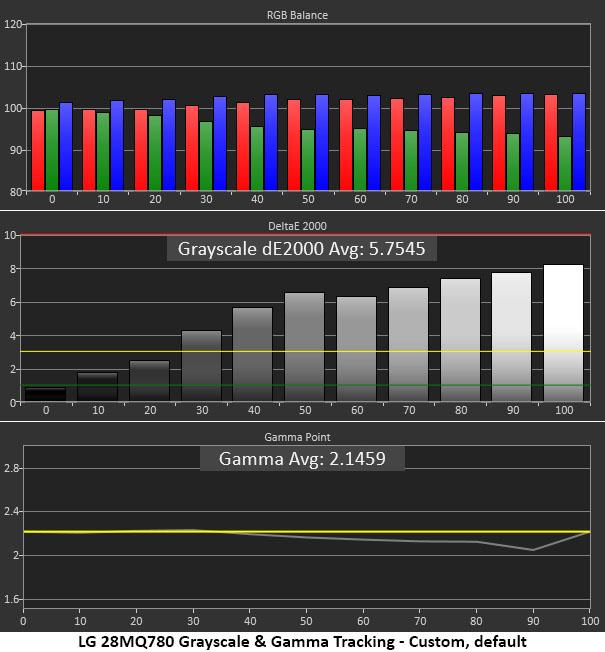
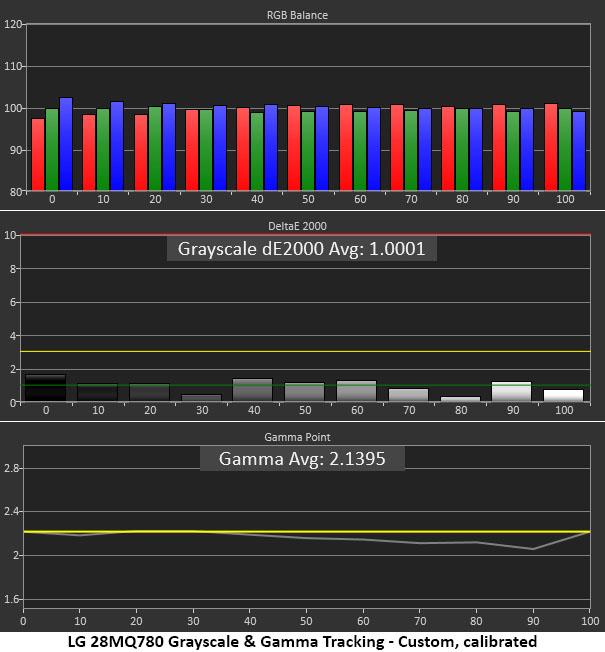
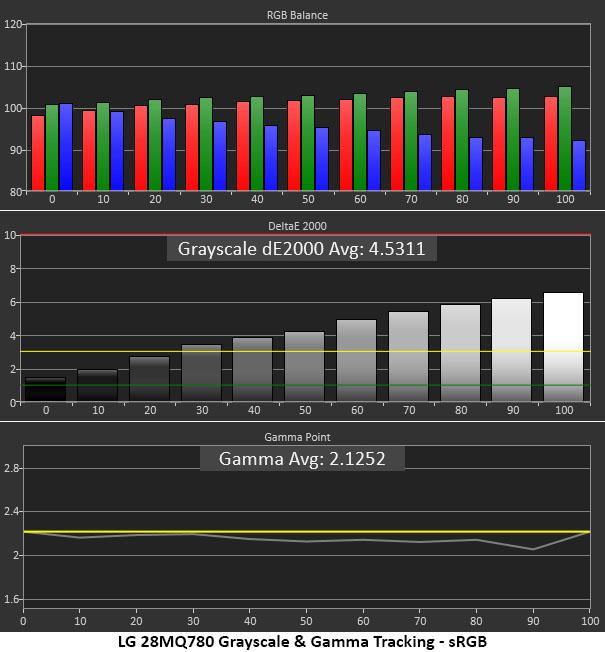
The 28MQ780 looks a tad purple out of the box with visible errors from 30% brightness up to the maximum white level. Given the promise of factory calibration, this is a little disappointing, but the errors are easily corrected. Tweaking the RGB sliders yields a visible and measurable gain in performance with the average grayscale error now at 1dE. Gamma tracks well with only a small dip in the middle and upper steps. This error is very minor and difficult to see in content.
The sRGB mode has a fixed color temperature which is a little reddish green. Again, the error is visible from 30% on up. Gamma tracking is nearly identical to Custom mode.
- Grayscale Error Default – 5.75dE
- Grayscale Error Calibrated – 1.00dE
- Gamma Value Range – 0.17
- Average Gamma, Deviation From 2.2 – 2.73% (2.14 actual value)
The 28MQ780’s default grayscale error of 5.75dE is a bit higher than I’d expect for a monitor at this price point. But it calibrates to the high standard I’d expect. With a tight 0.17 range of values and an average of 2.14, gamma runs close to the specification. This is very good performance overall.
Color Gamut Accuracy
Our color gamut and volume testing use Portrait Displays’ Calman software. For details on our color gamut testing and volume calculations, click here.

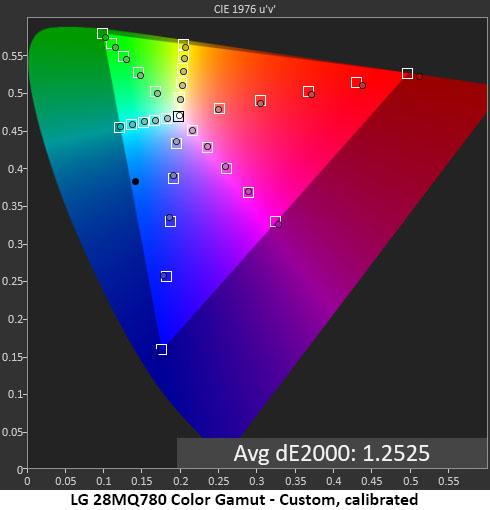
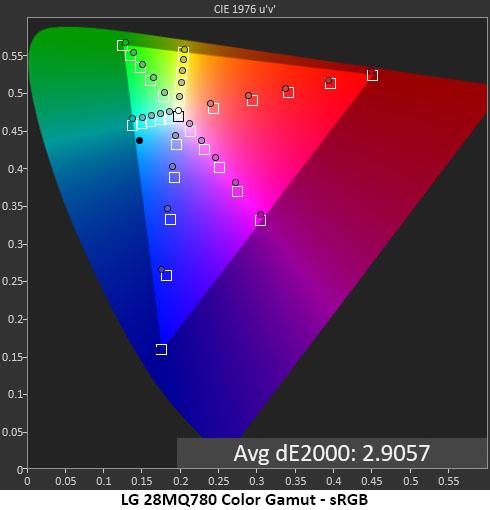
The 28MQ780’s Custom picture mode uses the monitor’s full native gamut, which covers nearly all of DCI-P3. You can see slight hue errors in the default chart that are in keeping with the white point error that moves toward the magenta secondary. The average error drops from 3.03dE to 1.25dE after the RGB sliders are adjusted. All color points are now in contact with their targets.
Get Tom's Hardware's best news and in-depth reviews, straight to your inbox.
The sRGB mode has no visible color errors with an average of 2.91dE. This is excellent performance.
- Color Gamut Error – 1.25dE (Custom), 2.91dE (sRGB)
- Color Gamut Volume – 95.52% DCI-P3, 104.6% sRGB
With such low color errors, both before and after calibration, I rate the 28MQ780’s color accuracy as excellent. The only thing required is adjustment of the RGB sliders to bring grayscale tracking in line.
Color gamut volume is among the best of the wide gamut displays I’ve tested. Only a handful of monitors are more colorful than the 28MQ780. It is well suited for color-critical apps. A software profile is recommended but not required since you can easily switch between DCI-P3 and sRGB modes.
Current page: Grayscale, Gamma and Color
Prev Page Brightness and Contrast Next Page HDR Performance
Christian Eberle is a Contributing Editor for Tom's Hardware US. He's a veteran reviewer of A/V equipment, specializing in monitors. Christian began his obsession with tech when he built his first PC in 1991, a 286 running DOS 3.0 at a blazing 12MHz. In 2006, he undertook training from the Imaging Science Foundation in video calibration and testing and thus started a passion for precise imaging that persists to this day. He is also a professional musician with a degree from the New England Conservatory as a classical bassoonist which he used to good effect as a performer with the West Point Army Band from 1987 to 2013. He enjoys watching movies and listening to high-end audio in his custom-built home theater and can be seen riding trails near his home on a race-ready ICE VTX recumbent trike. Christian enjoys the endless summer in Florida where he lives with his wife and Chihuahua and plays with orchestras around the state.
-
drajitsh Consider this vs 2 bog standard (200-250$) UHD monitors with vesa armsReply
1 . Games -- how many titles support a single monitor of this resolution vs dual monitor support. Of course both configurations would require some really high end GFX.
consuming video-- why would you require to see a play list this long.
Web browsing -- most websites would do better with a UHD in portrait mode, same for coding.
Photo and video editing -- you can have a professional monitor for the subject (photo or video) and a standard monitor for toolbars/thumbnails etc.
Request could you also give gamut volume and coverage vs AdobeRGB. Should not take very long and I think it still has relevance in print work. Also, every DSLR and mirrorless supports AdobeRGB -
helper800 Reply
I think its mainly for productivity and programming while being borderless. Two individual monitors next to each other is never going to be as nice as one large panel with no bezels.drajitsh said:Consider this vs 2 bog standard (200-250$) UHD monitors with vesa arms
1 . Games -- how many titles support a single monitor of this resolution vs dual monitor support. Of course both configurations would require some really high end GFX.
consuming video-- why would you require to see a play list this long.
Web browsing -- most websites would do better with a UHD in portrait mode, same for coding.
Photo and video editing -- you can have a professional monitor for the subject (photo or video) and a standard monitor for toolbars/thumbnails etc.Request could you also give gamut volume and coverage vs AdobeRGB. Should not take very long and I think it still has relevance in print work. Also, every DSLR and mirrorless supports AdobeRGB -
srl99 If you really like the shape, ok. Otherwise, save big $s and get a 4k. You'll also get more pixels.Reply
If you do buy this, get some protection against problems. LG "warranty" service will leave you with an empty desk for up to a month. -
voyteck ReplyWhen the first desktop LCD panels appeared, they too were made in 4:3 aspect like a television.
It's not entirely untrue since there were indeed 4 : 3 models from the beginning but I suppose you meant 5 : 4, which was the dominant aspect ratio. For example, EIZO in one of their first lineups of LCDs offered two models: L66 (1280 \00d7 1024, 5 : 4) and L360 (1024 \00d7 768, 4 : 3). -
bit_user Reply
Not the way I code. I often have about 4-5 files open at a time, usually positioned next to each other. Also, a couple terminal windows on a second monitor (or off in the corner of a single 4k monitor I sometimes use).brandonjclark said:This would be a pretty sweet coding monitor!
I do want a bit more vertical realestate, but this is too much. I wish 16:10 monitors were more popular. I had a 1920x1200 monitor and it was great. I'd love a 2560x1600. -
bit_user Reply
Depends on whether you use them for the same thing. I tend to put terminal windows and API docs on the second monitor, which is slightly off to the side. My primary is bigger and directly in front of me.helper800 said:Two individual monitors next to each other is never going to be as nice as one large panel with no bezels.
When I switch to a different setup with just a single 32" 4k monitor, I find I miss having the borders of the second monitor for facilitating window placement & layout. First world problems, I know. -
CooliPi My question is - how well does it work with Raspberry Pi 4 ? Are two HDMI outputs needed, or does it run with only one (it should)? Are there any problems like EDID information incompatibility, does it run out of the box etc.Reply
I think this would be a good monitor for coding - fitting most of the functions on one page, hence making better feeling for what's inside what (nested loops etc).
Raspberry Pi 4 is my personal workstation now, 'cause it's powerful enough for my needs and dead silent. And most of the time I'm doing research on the internet and writing code, browsing long logs, using ssh.
I've been waiting for this type of aspect ratio since widescreen BS came in. The reason not to get a widescreen monitor and rotate it is subpixel antialiasing though, which greatly helps with horizontal resolution (or vertical, if you rotate widescreen monitor, but I don't consider it usable for nice rendered alphabets).
Mind you, the vertical number of pixels is even higher than on my 16:10 4k monitor (2880 vs 2400). -
mickrc3 It sounds possible that this monitor size will become popular but consider that as a poineer device the LG is priced over the cost of many large 4K monitors and most usable 40in-60in 4K TVs. I just bought two LG 32in 32UL500-W 4K monitors during the Eggs sale at ran head-to-head with Prime Days. They were $250 each and though also only 60hz they did have adaptive sync. I'm running an Acer 48in 4K monitor which I used for coding plus I have a Samsung 28in 4K as a secondary monitor and I have an old Seiki 39in 4K which defaults to a TV but is also connected to my PC to function as a third monitor when needed. That's 3840x2160 per monitor and in the L shape that I have them set up in that gives me a tallest vertical of 4320 pixels and longest horizontal of 7680 pixels. I have used both long dimensions before especially when working on large spreadsheets.Reply
Even though I'm retired now I've kept the same arrangement as I am used to it.